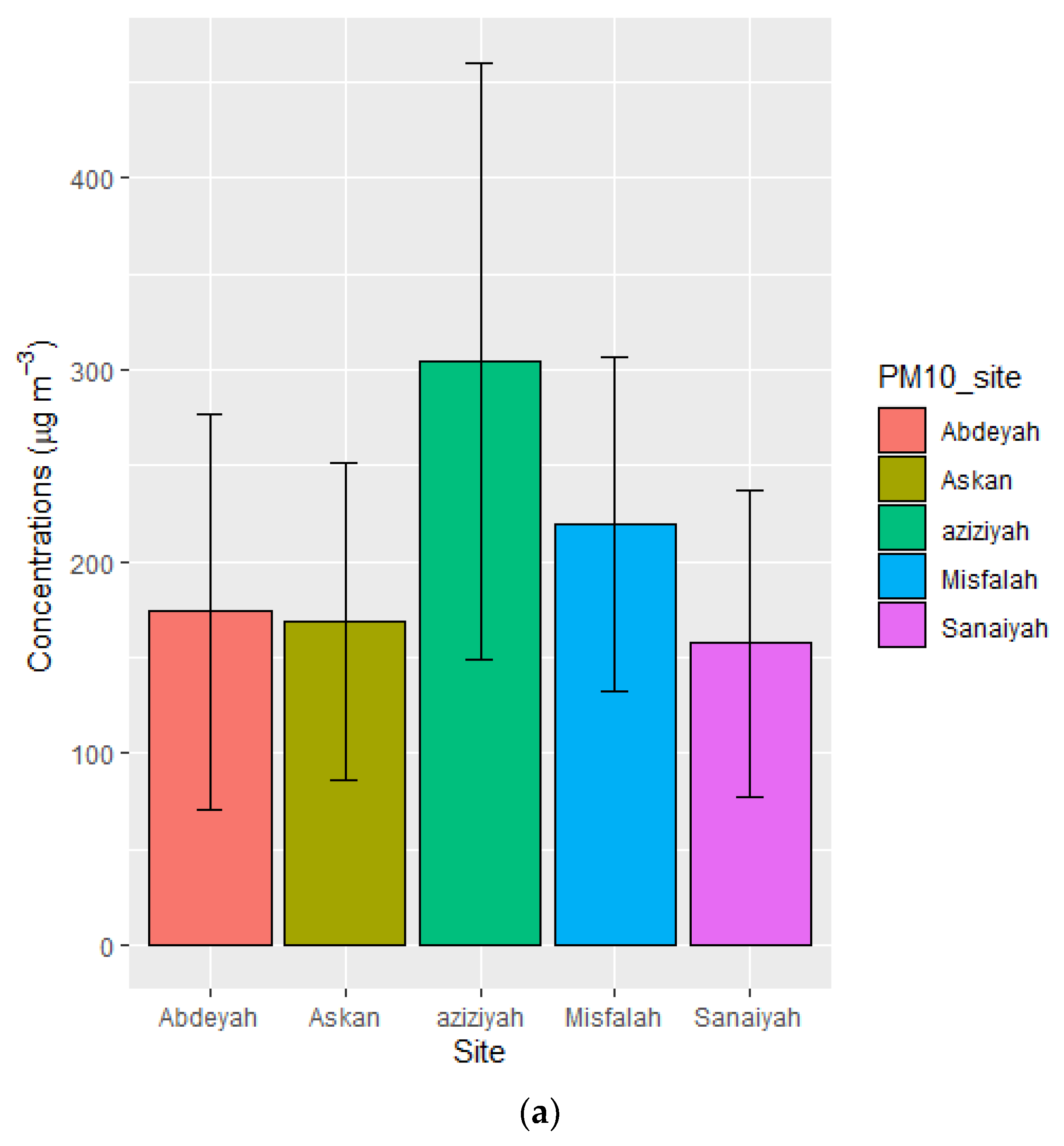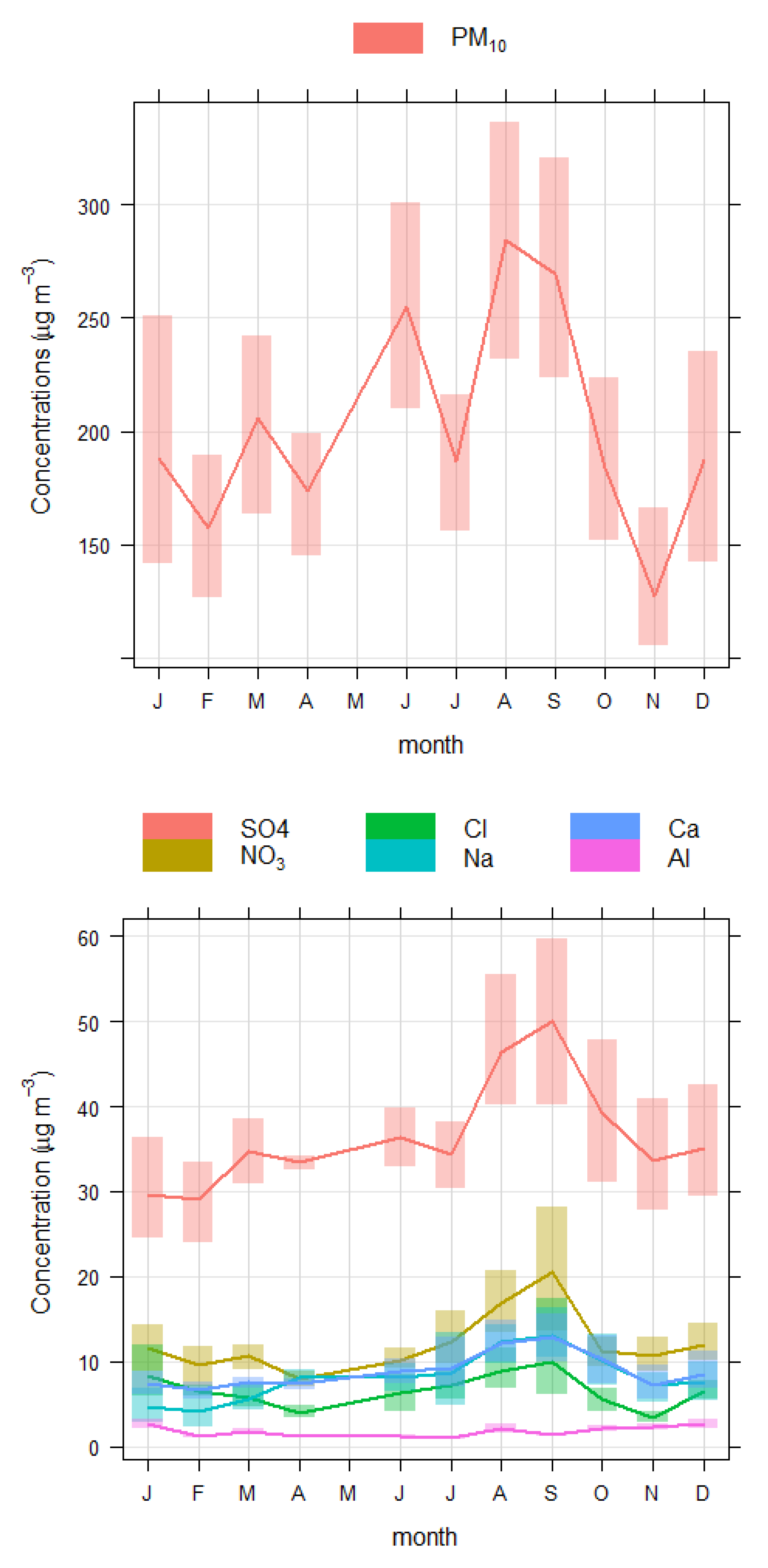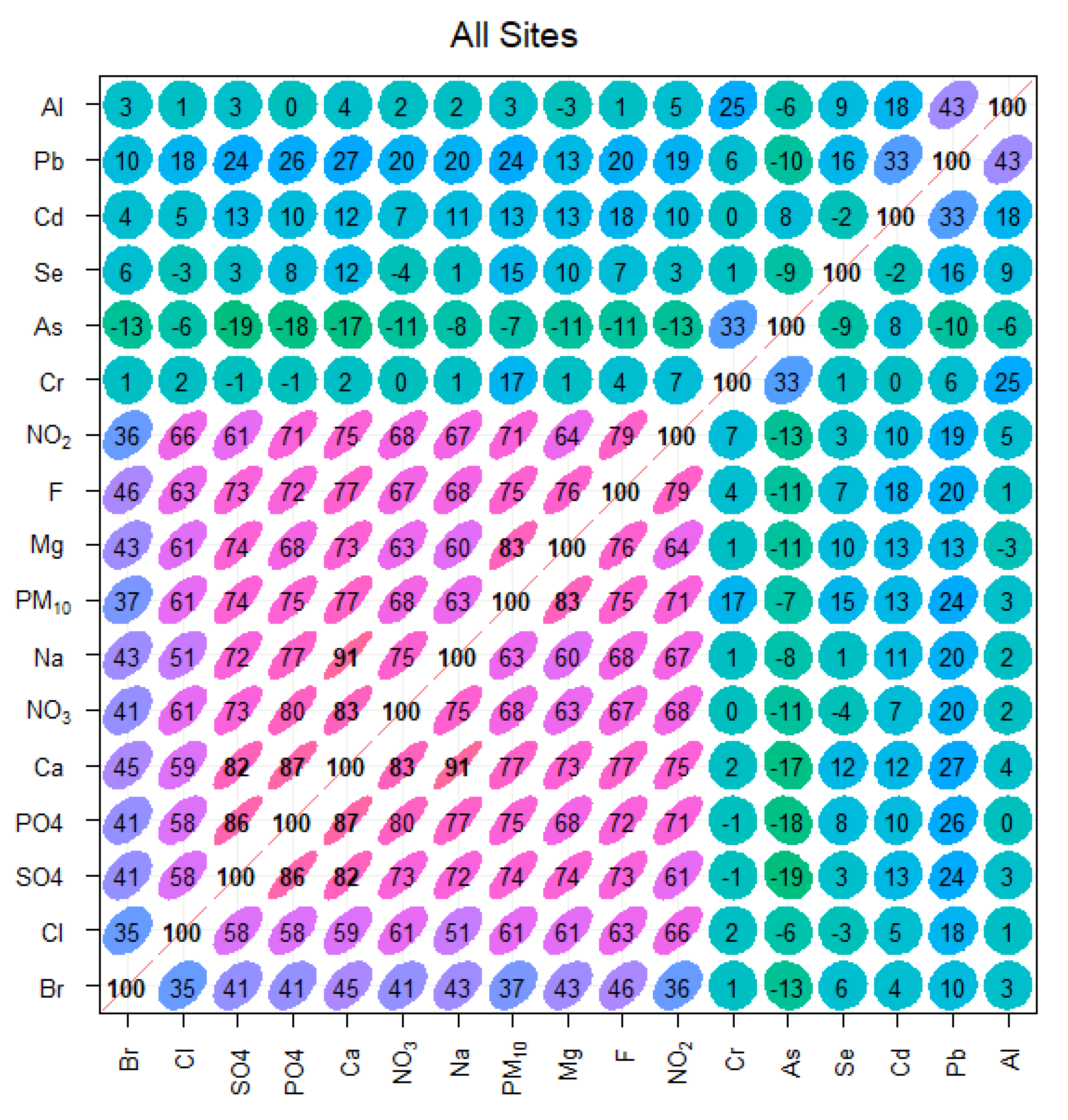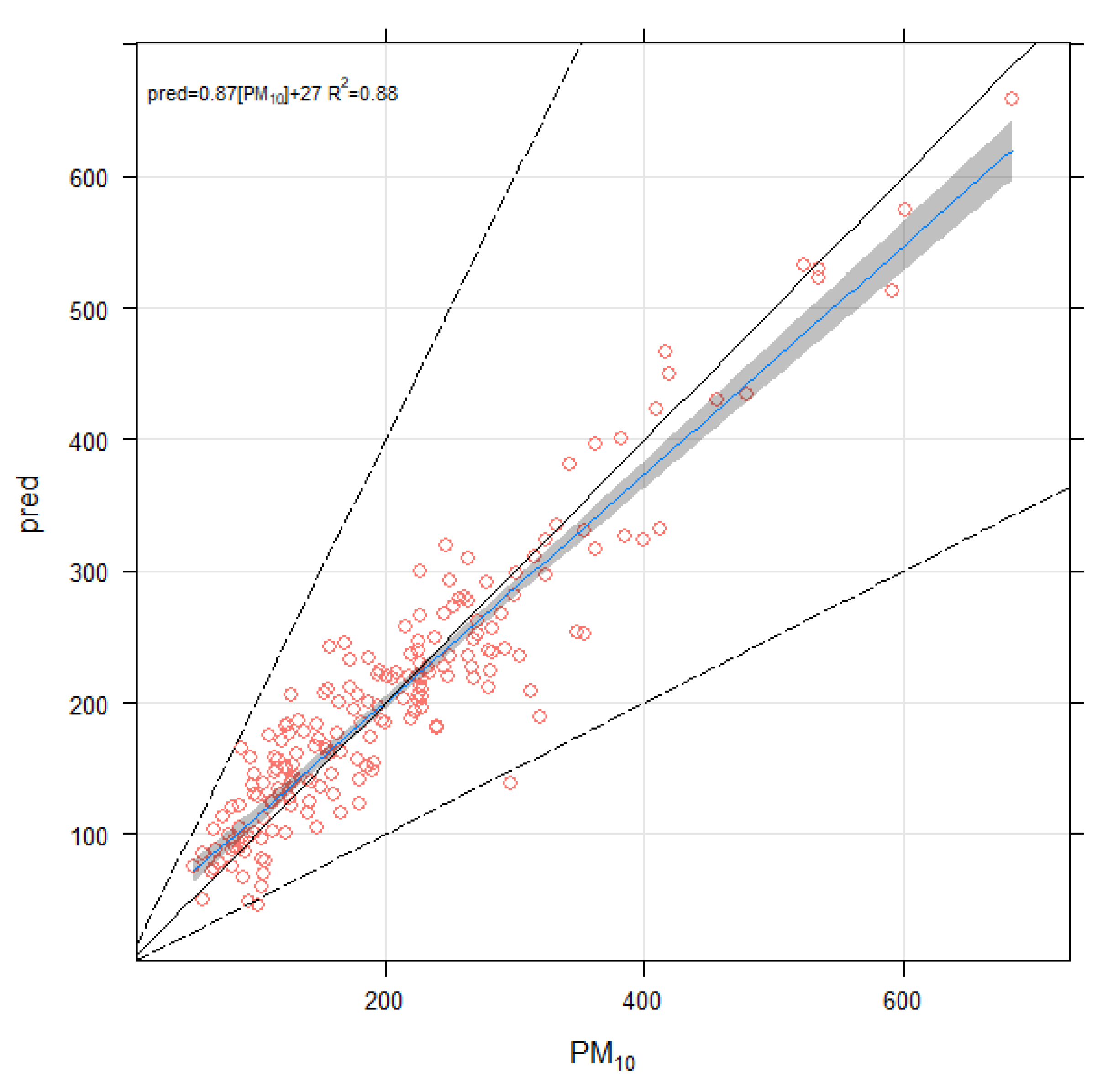Source Apportionment of Atmospheric PM10 in Makkah Saudi Arabia by Modelling Its Ion and Trace Element Contents with Positive Matrix Factorization and Generalised Additive Model
Abstract
:1. Introduction
2. Materials and Methods
2.1. Description of the Monitoring Sites
2.2. Collection of PM10 Samples
2.3. Analysis of Water-Soluble Ions and Metal Contents
2.4. General Statistical Analysis
2.5. Positive Matrix Factorization
2.6. Generalised Additive Model (GAM)
2.7. Enrichment Factor
3. Results and Discussion
3.1. Descriptive Analysis of PM10 and Its Constituents
3.2. Correlation Analysis
3.3. Generalised Additive Model (GAM)
3.4. Enrichment Factors (EF)
3.5. Positive Matrix Factorization (PMF)
4. Conclusions and Recommendation
- Road traffic including both exhaust and non-exhaust emission, and resuspension of dust (explained 51% variance in PM10);
- Industrial emissions and mineral dust (explained 27.5% variance);
- Restaurants and dwellings (explained 13.6% variance); and
- Other fossil fuel combustion (explained 7.9%).
- Road traffic is the main emission source of gaseous and particle pollution in Makkah. Therefore, it is important to effectively manage traffic flow to avoid congestion during the peak hours, particularly during the months of the Hajj and Ramadhan [61]. Also, the use of public transport should be encouraged;
- Further intervention for reducing air pollution in Makkah may include banning old polluting vehicles and retrofitting them with new technology [61];
- More electric vehicles should be included in the fleet and better charging facilities should be provided [62];
- To improve driving behaviour, further training should be provided to discourage abrupt acceleration, deceleration and idling [61]. Idling is a serious issue due to extremely high temperatures. Drivers keep their vehicle’s engines on during summer to keep the interior of the vehicle cold using the vehicle’s air conditioners. Otherwise, within a few minutes, the vehicle becomes unbearably hot. Environmentally friendly vehicles and technologies must be used in such situations;
- As previously reported by several authors [63], trees not only control air pollution but also help moderate air temperature. Therefore, more trees should be grown in the City of Makkah, particularly on roadsides;
- Large-scale construction and demolition activities increase the loading of atmospheric dust, which could be reduced by an effective water spray programme [64].
Author Contributions
Funding
Institutional Review Board Statement
Informed Consent Statement
Data Availability Statement
Acknowledgments
Conflicts of Interest
References
- World Health Organisation (WHO). Ambient (Outdoor) Air Pollution. 2018. Available online: https://www.who.int/news-room/fact-sheets/detail/ambient-(outdoor)-air-quality-and-health (accessed on 27 January 2022).
- Ramírez, O.; de la Campa, A.S.; Amato, F.; Catacolí, R.A.; Rojas, N.Y.; de la Rosa, J. Chemical composition and source apportionment of PM10 at an urban background site in a high–altitude Latin American megacity (Bogota, Colombia). Environ. Pollut. 2018, 233, 142–155. [Google Scholar] [CrossRef]
- Du, Y.; Xu, X.; Chu, M.; Guo, Y.; Wang, J. Air particulate matter and cardiovascular disease: The epidemiological, biomedical and clinical evidence. J. Thorac. Dis. 2016, 8, E8–E19. [Google Scholar] [CrossRef] [PubMed]
- Cowie, G.; Lawson, W.; Kim, N.D. Australian dust causing respiratory disease admissions in some North Island, New Zealand hospitals. N. Z. Med. J. 2010, 123. [Google Scholar]
- Weuve, J.; Puett, R.C.; Schwartz, J.; Yanosky, J.D.; Laden, F.; Grodstein, F. Exposure to Particulate Air Pollution and Cognitive Decline in Older Women. Arch. Intern. Med. 2012, 172, 219–227. [Google Scholar] [CrossRef] [PubMed] [Green Version]
- Baklanov, A.; Molina, L.T.; Gauss, M. Megacities, air quality and climate. Atmos. Environ. 2016, 126, 235–249. [Google Scholar] [CrossRef]
- Ryou, H.G.; Heo, J.; Kim, S.-Y. Source apportionment of PM10 and PM2.5 air pollution, and possible impacts of study characteristics in South Korea. Environ. Pollut. 2018, 240, 963–972. [Google Scholar] [CrossRef]
- Nayebare, S.R.; Aburizaiza, O.S.; Siddique, A.; Carpenter, D.O.; Hussain, M.M.; Zeb, J.; Aburiziza, A.J.; Khwaja, H.A. Ambient air quality in the holy city of Makkah: A source apportionment with elemental enrichment factors (EFs) and factor analysis (PMF). Environ. Pollut. 2018, 243, 1791–1801. [Google Scholar] [CrossRef]
- Khodeir, M.; Shamy, M.; Alghamdi, M.; Zhong, M.; Sun, H.; Costa, M.; Chen, L.-C.; Maciejczyk, P. Source apportionment and elemental composition of PM2.5 and PM10 in Jeddah City, Saudi Arabia. Atmos. Pollut. Res. 2012, 3, 331–340. [Google Scholar] [CrossRef] [Green Version]
- Farahat, A.; Chauhan, A.; Al Otaibi, M.; Singh, R.P. Air Quality Over Major Cities of Saudi Arabia During Hajj Periods of 2019 and 2020. Earth Syst. Environ. 2021, 5, 101–114. [Google Scholar] [CrossRef]
- Lim, C.C.; Thurston, G.D.; Shamy, M.; Alghamdi, M.; Khoder, M.; Mohorjy, A.M.; Alkhalaf, A.K.; Brocato, J.; Chen, L.C.; Costa, M.; et al. Temporal variations of fine and coarse particulate matter sources in Jeddah, Saudi Arabia. J. Air Waste Manag. Assoc. 2018, 68, 123–138. [Google Scholar] [CrossRef] [Green Version]
- Abbas, H.; Ghanem, S.; Abahussain, A. Assessing PM2.5 in Bahrain from the DPSIR Framework Perspective. In Proceedings of the 2021 Third International Sustainability and Resilience Conference: Climate Change, online, 15–16 November 2021; pp. 53–60. [Google Scholar]
- Javed, W.; Guo, B. Chemical characterization and source apportionment of fine and coarse atmospheric particulate matter in Doha, Qatar. Atmos. Pollut. Res. 2020, 12, 122–136. [Google Scholar] [CrossRef]
- Phanikumar, D.; Basha, G.; Ratnam, M.V.; Kondapalli, N.K.; Ouarda, T.; Pangaluru, K.; Kumar, K.N.; Kishore, P. Assessment of particulate matter concentration and gaseous pollutants in urban and rural regions over the Emirate of Abu Dhabi, UAE. J. Atmos. Sol.—Terr. Phys. 2020, 199, 105217. [Google Scholar] [CrossRef]
- Al-Thani, H.; Koc, M.; Fountoukis, C.; Isaifan, R.J. Evaluation of particulate matter emissions from non-passenger diesel vehicles in Qatar. J. Air Waste Manag. Assoc. 2020, 70, 228–242. [Google Scholar] [CrossRef] [PubMed]
- Alattar, N.; Yousif, J. Evaluating Particulate Matter (PM2.5 and PM10) Impact on Human Health in Oman Based on a Hybrid Artificial Neural Network and Mathematical Models. In Proceedings of the 2019 International Conference on Control, Artificial Intelligence, Robotics & Optimization (ICCAIRO), Majorca Island, Spain, 3–5 May 2019; pp. 129–135. [Google Scholar]
- Coskuner, G.; Jassim, M.S.; Munir, S. Characterizing temporal variability of PM2.5/PM10 ratio and its relationship with meteorological parameters in Bahrain. Environ. Forensics 2018, 19, 315–326. [Google Scholar] [CrossRef]
- Alam, K.; Trautmann, T.; Blaschke, T.; Subhan, F. Changes in aerosol optical properties due to dust storms in the Middle East and Southwest Asia. Remote Sens. Environ. 2014, 143, 216–227. [Google Scholar] [CrossRef]
- Farahat, A.; El-Askary, H.; Al-Shaibani, A. Study of Aerosols’ Characteristics and Dynamics over the Kingdom of Saudi Arabia Using a Multisensor Approach Combined with Ground Observations. Adv. Meteorol. 2015, 2015, 247531. [Google Scholar] [CrossRef] [Green Version]
- Habeebullah, T.M.; Munir, S.; Zeb, J.; Morsy, E.A. Analysis and Sources Identification of Atmospheric PM10 and Its Cation and Anion Contents in Makkah, Saudi Arabia. Atmoshere 2022, 13, 87. [Google Scholar] [CrossRef]
- Division, U.P. The World’s Cities in 2018: Data Booklet; United Nation: New York, NY, USA, 2018; ISBN 9789211483062. [Google Scholar]
- CDSI Central Department of Statistics and Information of Saudi Arabia. 2020. Available online: https://www.stats.gov.sa/en (accessed on 19 September 2021).
- Seroji, A. Particulates in the Atmosphere of Makkah and Mina Valley During Ramadan and Hajj Seasons of 1424 and 1425 H (2004–2005). Arab Gulf J. Sci. Res. 2008, 26, 199–206. [Google Scholar] [CrossRef] [Green Version]
- Habeebullah, T.M. An Analysis of Air Pollution in Makkah—A View Point of Source Identification. EnvironmentAsia 2013, 6, 11–17. [Google Scholar] [CrossRef]
- Almazroui, M.; Islam, M.N.; Athar, H.; Jones, P.D.; Rahman, M.A. Recent climate change in the Arabian Peninsula: Annual rainfall and temperature analysis of Saudi Arabia for 1978–2009. Int. J. Clim. 2012, 32, 953–966. [Google Scholar] [CrossRef]
- CARB. C.A.R.B. Standard Operating Procedure for the Determination of PM10 Mass by Gravimetric Analysis; Northern Laboratory Branch, Monitoring and Laboratory Division: Documents, CA, USA, 2018; Available online: https://fdocuments.in/document/table-of-contents-2020-6-30-determination-of-pm10-mass-by-gravimetric-analysis.html?page=1 (accessed on 12 January 2022).
- Ferreira, R.; Nunes, C.; Souza, M.; Canela, M. Multivariate Optimization of Extraction Variables of PAH in Particulate Matter (PM10) in Indoor/Outdoor Air at Campos dos Goytacazes, Brazil. J. Braz. Chem. Soc. 2021, 32, 618–625. [Google Scholar] [CrossRef]
- Waked, A.; Favez, O.; Alleman, L.Y.; Piot, C.; Petit, J.-E.; Delaunay, T.; Verlinden, E.; Golly, B.; Besombes, J.-L.; Jaffrezo, J.-L.; et al. Source apportionment of PM10 in a north-western Europe regional urban background site (Lens, France) using positive matrix factorization and including primary biogenic emissions. Atmos. Chem. Phys. 2014, 14, 3325–3346. [Google Scholar] [CrossRef] [Green Version]
- Rezaei, S.; Naddafi, K.; Hassanvand, M.S.; Nabizadeh, R.; Yunesian, M.; Ghanbarian, M.; Atafar, Z.; Faraji, M.; Nazmara, S.; Mahmoudi, B.; et al. Physiochemical characteristics and oxidative potential of ambient air particulate matter (PM10) during dust and non-dust storm events: A case study in Tehran, Iran. J. Environ. Health Sci. Eng. 2018, 16, 147–158. [Google Scholar] [CrossRef]
- Liu, H.; Zheng, J.; Qu, C.; Zhang, J.; Wang, Y.; Zhan, C.; Yao, R.; Cao, J. Characteristics and Source Analysis of Water-Soluble Inorganic Ions in PM10 in a Typical Mining City, Central China. Atmosphere 2017, 8, 74. [Google Scholar] [CrossRef] [Green Version]
- Sowlat, M.H.; Naddafi, K.; Yunesian, M.; Jackson, P.L.; Lotfi, S.; Shahsavani, A. PM10 Source Apportionment in Ahvaz, Iran, Using Positive Matrix Factorization | Enhanced Reader. Celan—Soil Air Water 2013, 41, 1143–1151. [Google Scholar] [CrossRef]
- EPA, U. IO Compendium Method IO-3.1: Compendium of Methods for the Determination of Inorganic Compunds in Ambient Air: Selection, Preparation and Extraction of Filter Material; EPA/625/R-; Centre for Environmental Research Information, Office of Research and Development, US EPA: Cinncinati, OH, USA, 1999. [Google Scholar]
- Ali, N.; Eqani, S.A.M.A.S.; Nazar, E.; Alhakamy, N.A.; Rashid, M.I.; Shahzad, K.; Zeb, J.; Shen, H.; Ismail, I.M.I.; Albar, H.M.S.A. Arsenic and lead in the indoor residential settings of different socio-economic status; assessment of human health risk via dust exposure. Environ. Sci. Pollut. Res. 2020, 28, 13288–13299. [Google Scholar] [CrossRef] [PubMed]
- Kadi, M.W.; Ismail, I.; Ali, N.; Shaltout, A.A. Spectroscopic Assessment of Platinum Group Elements of PM10 Particles Sampled in Three Different Areas in Jeddah, Saudi Arabia. Int. J. Environ. Res. Public Health 2020, 17, 3339. [Google Scholar] [CrossRef]
- Team, R.C.; R Core Team. R: A Language and Environment for Statistical Computing; R Foundation for Statistical Computing: Vienna, Austria, 2020; Available online: http://www.r-project.org/index.html (accessed on 20 April 2021).
- Carslaw, D. The Openair Manual: Open-Source Tools for Analysing Air Pollution Data. Available online: https://davidcarslaw.github.io/openair/ (accessed on 12 November 2021).
- Wood, S. The Mgcv Package: Mixed GAM Computation Vehicle with Automatic Smoothness Estimation. 2020. Available online: https://cran.r-project.org/web/packages/mgcv/index.html (accessed on 23 January 2022).
- Wickham, H. Ggplot2: Elegant Graphics for Data Analysis, 2nd ed.; Springer: Cham, Switzerland, 2016; ISBN 9783319242774. [Google Scholar]
- Sun, X.; Wang, H.; Guo, Z.; Lu, P.; Song, F.; Liu, L.; Liu, J.; Rose, N.; Wang, F. Positive matrix factorization on source apportionment for typical pollutants in different environmental media: A review. Environ. Sci. Process. Impacts 2020, 22, 239–255. [Google Scholar] [CrossRef]
- Paatero, P. Least squares formulation of robust non-negative factor analysis. Chemom. Intell. Lab. Syst. 1997, 37, 23–35. [Google Scholar] [CrossRef]
- Hwang, I. Introduction and Application of the PMF Model to Estimate the Source Apportionment of PM2.5 at Various Sites. J. Inst. Eng. 1970, 8, 25–31. [Google Scholar] [CrossRef]
- EPA. EPA Positive Matrix Factorization (PMF) 5.0 Fundamentals and User Guide; EPA/600/R-.; U.S. Environmental Protection Agency, Office of Research and Development: Washington, DC, USA, 2014. [Google Scholar]
- Hastie, T.J. Generalized Additive Models, 1st ed.; Chapman and Hall: London, UK; CRC: London, UK, 1990; ISBN 0-412-34390-8. [Google Scholar]
- Wood, S.N. Generalized Additive Models: An Introduction with R; Chapman & Hall: Boca Raton, FL, USA, 2006; ISBN 9781584884743. [Google Scholar]
- Fabretti, J.-F.; Sauret, N.; Gal, J.-F.; Maria, P.-C.; Schärer, U. Elemental characterization and source identification of PM2.5 using Positive Matrix Factorization: The Malraux road tunnel, Nice, France. Atmos. Res. 2009, 94, 320–329. [Google Scholar] [CrossRef]
- Aprile, F.M.; Bouvy, M. Distribution and enrichment of heavy metals at the Tapacurá River basin, northeastern Brazil. Braz. J. Aquat. Sci. Technol. 2008, 12, 1–8. [Google Scholar] [CrossRef] [Green Version]
- Taylor, S.R. Abundance of chemical elements in the continental crust: A new table. Geochim. Cosmochim. Acta 1964, 28, 1273–1285. [Google Scholar] [CrossRef]
- ArRiyadh Air Quality. Air Quality Standards, Legislations and Policy. Available online: http://aq.arriyadhenv.gov.sa/aq/about-us/riyadh-air-quality-standards/ (accessed on 8 January 2022).
- Al-Taani, A.A.; Nazzal, Y.; Howari, F.M.; Yousef, A. Long-term trends in ambient fine particulate matter from 1980 to 2016 in United Arab Emirates. Environ. Monit. Assess. 2019, 191, 143. [Google Scholar] [CrossRef] [PubMed]
- Farahat, A.; El-Askary, H.; Dogan, A.U. Aerosols Size Distribution Characteristics and Role of Precipitation during Dust Storm Formation over Saudi Arabia. Aerosol Air Qual. Res. 2016, 16, 2523–2534. [Google Scholar] [CrossRef] [Green Version]
- Farahat, A. Comparative analysis of MODIS, MISR, and AERONET climatology over the Middle East and North Africa. Ann. Geophys. 2019, 37, 49–64. [Google Scholar] [CrossRef] [Green Version]
- Carslaw, D. Defra Regional and Transboundary Model Evaluation Analysis—Phase 1; Version 15; UK AIR: London, UK, 2011; Available online: https://uk-air.defra.gov.uk/library/reports?report_id=653 (accessed on 24 December 2021).
- Munir, S.; Habeebullah, T.M.; Seroji, A.; Morsy, E.A.; Mohammed, A.M.; Abu Saud, W.; Abdou, A.E.; Awad, A.H. Modeling Particulate Matter Concentrations in Makkah, Applying a Statistical Modeling Approach. Aerosol Air Qual. Res. 2013, 13, 901–910. [Google Scholar] [CrossRef] [Green Version]
- Grigoratos, T.; Martini, G. Brake wear particle emissions: A review. Environ. Sci. Pollut. Res. Int. 2015, 22, 2491–2504. [Google Scholar] [CrossRef] [Green Version]
- Kennedy, P.; Gadd, J. Preliminary Examination of Trace Elements in Tyres, Brake Pads and Road Bitumen in New Zealand; Infrastructure Auckland: Auckland, New Zealand, 2003. [Google Scholar]
- Feinberg, A.; Maliki, M.; Stenke, A.; Sudret, B.; Peter, T.; Winkel, L.H.E. Mapping the drivers of uncertainty in atmospheric selenium deposition with global sensitivity analysis. Atmos. Chem. Phys. 2020, 20, 1363–1390. [Google Scholar] [CrossRef]
- Chen, L.; Peng, C.; Gu, W.; Fu, H.; Jian, X.; Zhang, H.; Zhang, G.; Zhu, J.; Wang, X.; Tang, M. On mineral dust aerosol hygroscopicity. Atmos. Chem. Phys. 2020, 20, 13611–13626. [Google Scholar] [CrossRef]
- WHO. WHO Air Quality Guidelines for Europe, 2nd ed.; WHO: Geneva, Switzerland, 2000; Available online: https://www.euro.who.int/en/health-topics/environment-and-health/air-quality/publications/pre2009/who-air-quality-guidelines-for-europe,-2nd-edition,-2000-cd-rom-version. (accessed on 1 October 2021).
- Emsley, J. Nature’s Building Blocks: Everything You Need to Know about the Elements, 2nd ed.; Oxford University Press: Oxford, UK, 2011; ISBN 9780199605637. [Google Scholar]
- Cheng, H.; Zhou, T.; Li, Q.; Lu, L.; Lin, C. Anthropogenic Chromium Emissions in China from 1990 to 2009. PLoS ONE 2014, 9, e87753. [Google Scholar] [CrossRef] [PubMed]
- Simpson, I.J.; Aburizaiza, O.S.; Siddique, A.; Barletta, B.; Blake, N.J.; Gartner, A.; Khwaja, H.; Meinardi, S.; Zeb, J.; Blake, D.R. Air Quality in Mecca and Surrounding Holy Places in Saudi Arabia During Hajj: Initial Survey. Environ. Sci. Technol. 2014, 48, 8529–8537. [Google Scholar] [CrossRef] [PubMed] [Green Version]
- Barisione, M. Electric Vehicles and Air Pollution: The Claims and the Facts. Available online: https://epha.org/electric-vehicles-and-air-pollution-the-claims-and-the-facts/ (accessed on 25 January 2022).
- Munir, S.; Habeebullah, T.M.; Morsy, E.A.; Mohammed, M.F. The Effect of Tree Plantations on Moderating Air Temperature in Arafat, Makkah for the Period 2002-2016. J. King Abdulaziz Univ. Environ. Arid Land Agric. Sci. 2018, 27, 63–72. [Google Scholar] [CrossRef]
- Munir, S.; Habeebullah, T.M.; Seroji, A.R.; Gabr, S.S.; Mohammed, A.M.; Morsy, E.A. Quantifying temporal trends of atmospheric pollutants in Makkah (1997–2012). Atmos. Environ. 2013, 77, 647–655. [Google Scholar] [CrossRef]










| Element | Earth-Crust Cx | PM10 Cx | (Cx/CAl) PM10 | (Cx/CAl) Earth-Crust | EF |
|---|---|---|---|---|---|
| Al | 8.230 | 1.784 | 1.000 | 1.000 | 1.000 |
| Pb | 12.500 | 0.161 | 0.090 | 1.519 | 0.059 |
| Cd | 0.200 | 0.085 | 0.048 | 0.024 | 1.961 |
| Cr | 100.000 | 0.017 | 0.010 | 12.151 | 0.001 |
| As | 1.800 | 0.085 | 0.048 | 0.219 | 0.218 |
| Se | 0.050 | 0.004 | 0.002 | 0.006 | 0.369 |
| F | 525.000 | 0.330 | 0.185 | 63.791 | 0.003 |
| Cl | 130.000 | 6.837 | 3.832 | 15.796 | 0.243 |
| Br | 2.500 | 0.042 | 0.024 | 0.304 | 0.078 |
| Na | 2.360 | 8.596 | 4.818 | 0.287 | 16.803 |
| Ca | 4.150 | 9.341 | 5.236 | 0.504 | 10.384 |
| Mg | 2.330 | 0.444 | 0.249 | 0.283 | 0.879 |
| Profile (% of Species) | Profile (% of Factor Total) | Profile (Concentration of Species) | ||||||||||
|---|---|---|---|---|---|---|---|---|---|---|---|---|
| Factor 1 | Factor 2 | Factor 3 | Factor 4 | Factor 1 | Factor 2 | Factor 3 | Factor 4 | Factor 1 | Factor 2 | Factor 3 | Factor 4 | |
| PM10 | 27.48 | 7.87 | 51.01 | 13.64 | 78.59 | 54.56 | 71.52 | 82.83 | 56.66 | 16.23 | 105.16 | 28.11 |
| Pb | 34.04 | 59.22 | 6.74 | <0.01 | 0.08 | 0.33 | 0.01 | <0.01 | 0.06 | 0.10 | 0.01 | <0.01 |
| Cd | <0.01 | 93.19 | 6.39 | 0.42 | <0.01 | 0.28 | <0.01 | <0.01 | <0.01 | 0.08 | 0.01 | <0.01 |
| Cr | 23.23 | 5.81 | 4.88 | 66.08 | 0.01 | <0.01 | <0.01 | 0.03 | <0.01 | <0.01 | <0.01 | 0.01 |
| As | <0.00 | <0.01 | <0.01 | 100.00 | <0.01 | <0.01 | <0.01 | 0.25 | <0.01 | <0.01 | <0.01 | 0.08 |
| Se | 97.28 | <0.01 | <0.01 | 2.72 | <0.01 | <0.01 | <0.01 | <0.01 | <0.01 | <0.01 | <0.01 | <0.01 |
| Al | 36.74 | 51.03 | <0.01 | 12.22 | 0.91 | 3.06 | 0.00 | 0.64 | 0.66 | 0.91 | <0.01 | 0.22 |
| F | 6.28 | 7.49 | 82.64 | 3.59 | 0.03 | 0.09 | 0.19 | 0.04 | 0.02 | 0.03 | 0.28 | 0.01 |
| Cl | 14.51 | 12.38 | 62.54 | 10.56 | 1.34 | 2.78 | 2.84 | 2.08 | 0.97 | 0.83 | 4.17 | 0.70 |
| NO2 | <0.01 | <0.01 | 100.00 | <0.01 | <0.01 | <0.01 | 0.01 | <0.01 | <0.01 | <0.01 | 0.01 | <0.01 |
| Br | 24.14 | 15.25 | 57.36 | 3.25 | 0.01 | 0.02 | 0.02 | <0.01 | 0.01 | 0.01 | 0.02 | <0.01 |
| NO3 | 12.25 | 15.71 | 65.40 | 6.63 | 2.15 | 6.67 | 5.62 | 2.47 | 1.55 | 1.98 | 8.26 | 0.84 |
| PO4 | 5.16 | 5.88 | 88.96 | <0.01 | 0.02 | 0.05 | 0.16 | <0.01 | 0.01 | 0.02 | 0.24 | <0.01 |
| SO4 | 26.01 | 19.96 | 45.61 | 8.41 | 13.08 | 24.32 | 11.24 | 8.99 | 9.43 | 7.24 | 16.53 | 3.05 |
| Na | 9.19 | 12.61 | 73.42 | 4.78 | 1.09 | 3.63 | 4.27 | 1.21 | 0.79 | 1.08 | 6.29 | 0.41 |
| Ca | 19.59 | 13.10 | 62.53 | 4.78 | 2.53 | 4.10 | 3.96 | 1.31 | 1.83 | 1.22 | 5.83 | 0.45 |
| Mg | 27.02 | 8.09 | 53.11 | 11.77 | 0.16 | 0.12 | 0.16 | 0.15 | 0.12 | 0.04 | 0.23 | 0.05 |
Publisher’s Note: MDPI stays neutral with regard to jurisdictional claims in published maps and institutional affiliations. |
© 2022 by the authors. Licensee MDPI, Basel, Switzerland. This article is an open access article distributed under the terms and conditions of the Creative Commons Attribution (CC BY) license (https://creativecommons.org/licenses/by/4.0/).
Share and Cite
Habeebullah, T.M.; Munir, S.; Zeb, J.; Morsy, E.A. Source Apportionment of Atmospheric PM10 in Makkah Saudi Arabia by Modelling Its Ion and Trace Element Contents with Positive Matrix Factorization and Generalised Additive Model. Toxics 2022, 10, 119. https://doi.org/10.3390/toxics10030119
Habeebullah TM, Munir S, Zeb J, Morsy EA. Source Apportionment of Atmospheric PM10 in Makkah Saudi Arabia by Modelling Its Ion and Trace Element Contents with Positive Matrix Factorization and Generalised Additive Model. Toxics. 2022; 10(3):119. https://doi.org/10.3390/toxics10030119
Chicago/Turabian StyleHabeebullah, Turki M., Said Munir, Jahan Zeb, and Essam A. Morsy. 2022. "Source Apportionment of Atmospheric PM10 in Makkah Saudi Arabia by Modelling Its Ion and Trace Element Contents with Positive Matrix Factorization and Generalised Additive Model" Toxics 10, no. 3: 119. https://doi.org/10.3390/toxics10030119
APA StyleHabeebullah, T. M., Munir, S., Zeb, J., & Morsy, E. A. (2022). Source Apportionment of Atmospheric PM10 in Makkah Saudi Arabia by Modelling Its Ion and Trace Element Contents with Positive Matrix Factorization and Generalised Additive Model. Toxics, 10(3), 119. https://doi.org/10.3390/toxics10030119








